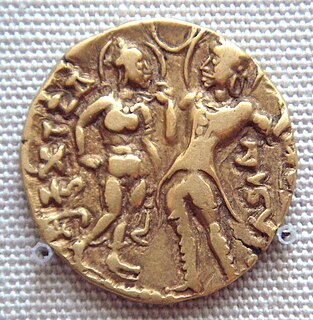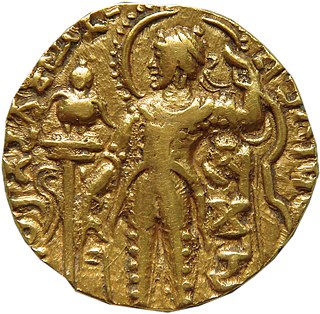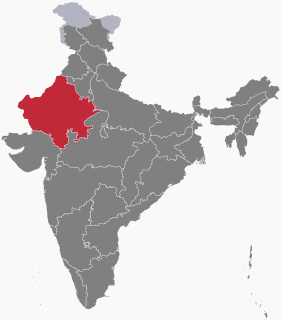
The Gupta Empire was an ancient Indian empire existing from the mid-to-late 3rd century CE to 543 CE. At its zenith, from approximately 319 to 467 CE, it covered much of the Indian subcontinent. This period is considered as the Golden Age of India by historians. The ruling dynasty of the empire was founded by the king Sri Gupta; the most notable rulers of the dynasty were Chandragupta I, Samudragupta, and Chandragupta II alias Vikramaditya. The 5th-century CE Sanskrit poet Kalidasa credits the Guptas with having conquered about twenty-one kingdoms, both in and outside India, including the kingdoms of Parasikas, the Hunas, the Kambojas, tribes located in the west and east Oxus valleys, the Kinnaras, Kiratas, and others.

Chandragupta II, also known by his title Vikramaditya, was one of the most powerful emperors of the Gupta Empire in northern India.

Chandragupta I was a king of the Gupta dynasty, who ruled in northern India. His title Maharajadhiraja suggests that he was the first emperor of the dynasty. It is not certain how he turned his small ancestral kingdom into an empire, although a widely accepted theory among modern historians is that his marriage to the Lichchhavi princess Kumaradevi helped him extend his political power. Their son Samudragupta further expanded the Gupta empire.

Samudragupta (Gupta script: Sa-mu-dra-gu-pta, r. c. was a ruler of the Gupta Empire of Ancient India. As a son of the Gupta emperor Chandragupta I and the Lichchhavi princess Kumaradevi, he greatly expanded his dynasty's political power.

The Middle kingdoms of India were the political entities in India from the 3rd century BCE to the 13th century CE. The period begins after the decline of the Maurya Empire and the corresponding rise of the Satavahana dynasty, starting with Simuka, from 230 BCE. The "Middle" period lasted for about 1,500 years and ended in the 13th century, with the rise of the Delhi Sultanate, founded in 1206, and the end of the Later Cholas.

The Nanda dynasty ruled in the northern part of the Indian subcontinent during the 4th century BCE, and possibly during the 5th century BCE. The Nandas overthrew the Shaishunaga dynasty in the Magadha region of eastern India, and expanded their empire to include a larger part of northern India. Ancient sources differ considerably regarding the names of the Nanda kings, and the duration of their rule, but based on the Buddhist tradition recorded in the Mahavamsa, they appear to have ruled during c. 345–322 BCE, although some theories date the start of their rule to 5th century BCE.

The Satavahanas, also referred to as the Andhras in the Puranas, were an ancient Indian dynasty based in the Deccan region. Most modern scholars believe that the Satavahana rule began in the late second century BCE and lasted until the early third century CE, although some assign the beginning of their rule to as early as the 3rd century BCE based on the Puranas, but uncorroborated by archaeological evidence. The Satavahana kingdom mainly comprised the present-day Andhra Pradesh, Telangana, and Maharashtra. At different times, their rule extended to parts of modern Gujarat, Madhya Pradesh, and Karnataka. The dynasty had different capital cities at different times, including Pratishthana (Paithan) and Amaravati (Dharanikota).

The history of human settlement in the west Indian state of Rajasthan dates back to about 5,000 years ago. This region was inhabited during great floods after the ice age as well. This area was known as Matsya kingdom. It was the site of the Indus Valley Civilization. The early medieval period saw the rise of many Rajput kingdoms like Pratihars,Chauhans of Ajmer, Guhilot and Sisodias of Mewar, Shekhawats of Shekhawati Sikar, Rathores of Marwar.

The Tomara dynasty ruled parts of present-day Delhi and Haryana in India during 8th-12th century. Their rule over this region is attested to by multiple inscriptions and coins. In addition, much of the information about them comes from medieval bardic legends, which are not historically reliable. They were displaced by the Chahamanas of Shakambhari in the 12th century.

The Bharshiva dynasty was the most powerful dynasty of the pre-Gupta period. The Nagas of Vidisha moved to Mathura and start annexing other kingdoms under Virasena. They made Padmavati Pawaya, Kantipuri and Vidisha their capitals and placed their family members as rulers of the states. They ruled parts of north-central India during the 3rd and the 4th centuries, after the decline of the Kushan Empire and before the rise of the Gupta Empire. Its capital was located at Padmavati, which is identified with modern Pawaya in Madhya Pradesh. Modern historians identify it with the family that is called Bharashiva in the records of the Vakataka dynasty.

The Chaulukya dynasty was a dynasty that ruled parts of what are now Gujarat and Rajasthan in north-western India, between c. 940 CE and c. 1244 CE. Their capital was located at Anahilavada. At times, their rule extended to the Malwa region in present-day Madhya Pradesh. The family is also known as the Solanki dynasty in the vernacular literature.
The Kachchhapaghatas were an Indian dynasty that ruled between 10th and 12th centuries. Their territory included north-western parts of Central India.
The Chahamanas of Shakambhari, colloquially known as the Chauhans of Sambhar, were a dynasty that ruled parts of the present-day Rajasthan and its neighbouring areas in India, between the 6th and 12th centuries. The territory ruled by them was known as Sapadalaksha. They were the most prominent ruling family of the Chahamana (Chauhan) clan, and were categorized among Agnivanshi Rajputs in the later medieval legends.
The Kalachuris of Tripuri, also known the Kalachuris of Chedi, ruled parts of central India during 7th to 13th centuries. Their core territory included the historical Chedi region, and their capital was located at Tripuri.
The Guhila dynasty ruled the Medapata region in present-day Rajasthan state of India. The Guhila kings initially ruled as Gurjara-Pratihara vassals between 8th and 10th centuries. Their capitals included Nagahrada (Nagda) and Aghata (Ahar). For this reason, they are also known as the Nagda-Ahar branch of the Guhilas.
Someshvara was an Indian king belonging to the Chahamana dynasty and ruled parts of present-day Rajasthan in north-western India. He was brought up at the Chaulukya court in Gujarat by his maternal relatives. After death of Prithviraja II, the Chahamana ministers brought him to the capital Ajmer and appointed him as the new king. He is said to have commissioned several Shiva temples in Ajmer, and is best known as the father of Prithviraja III.
Kirti-pala, also known as Kitu in vernacular legends, was an Indian king belonging to the Chahamana dynasty of Javalipura. A member of the Naddula Chahamana family, he carved out a principality for himself with Jalore at its capital. He ruled parts of southern Rajasthan as a feudatory of the Chaulukyas, and participated in their successful battle against Muhammad of Ghor in 1178 CE. He also fought with other Chaulukya feudatories, including Asala of Kiratakupa and the Guhila chief Samantasimha.
Ajayapala was an Indian king from the Chaulukya (Solanki) dynasty of Gujarat. He ruled the present-day Gujarat and surrounding areas for a short period, from his capital Anahilapataka.
The Shailodbhava dynasty ruled parts of eastern India during the 6th-8th centuries. Their core territory was known as Kongoda-mandala, and included parts of the present-day Ganjam, Khordha and Puri districts in the Odisha state. Their capital was located at Kongoda, which is identified with modern Banapur.
Vinayaditya may refer to any of the following kings who ruled in present-day India:










